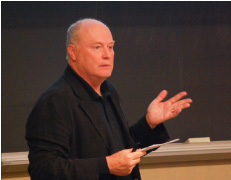
By Brendan McGrath
Correspondent
The carpets of Central Asia represent a history full of tradition, as well as of commercialization. These weavings symbolize the regions of origin and serve as a commentary to the local culture. Peter Poullada, a scholar on these weavings, visited the College last Thursday to speak about their cultural importance and address common misconceptions about their origins.
Focusing on the Turkmen tribes of the Lebab region in present day Turkmenistan and Afghanistan, Poullada depicted the ceremonious, as well as utilitarian, role carpets played in 18th and 19th century society.
Carpet weaving was intricately entwined into the marital system of the Turkmen and provided women with a canvas on which they could exert creative control. Women also brought weavings with them as dowries into their marriages and used them to adorn their new homes.
“It’s her world that we’re really trying to deal with here,” Poullada said.
Paradoxically, “her world” was one of both seclusion and intimate participation in culture, according to Poullada. While women weren’t involved in the trade of these weavings, they were the ones who designed and made them.
“The carpets that they (the Turkmen) produced … were made 100 percent by the women,” Poullada said.
While Poullada frequently noted that men had little to do with the production of the carpets, he also spoke on their role in commercializing the tradition of weaving.
Originally intended as dowry offerings, weavings were a prominent piece of the spectacular wedding ceremonies held in the Lebab region. They, however, slowly became items produced for sale.
The introduction of a Transcontinental Railroad greatly influenced this transformation, as it brought Russian and Armenian traders into the fold. Consequently demand for these traditional weavings developed in Western markets.
“There’s no question that the impact the railway had … accelerated commercialization of carpets in the region,” Poullada said.
Beyond the discussion on the cultural impact of the carpets, Poullada expressed his views on the incorrect categorization of much of the weaving that comes from the Lebab region. He spoke of how the region had more than 30 tribes, but noted that nearly all weavings from this area fell into two tribal classifications. This, he asserted, was almost certainly an error.
Poullada invited audience members to approach the front of the room to observe the 18th and 19th century weavings he brought to display.
This event was sponsored by a grant the College received to promote growth in International Studies programs.






